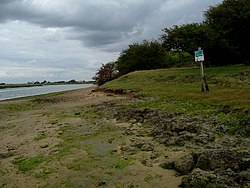Ray Island
| Ray Island | |
 Ray Island | |
|---|---|
| Location | |
| Location: | 51°48’4"N, 0°54’54"E |
| Grid reference: | TM011154 |
| Area: | 100 acres |
| Data | |
Ray Island, also known as the Ray, is an uninhabited island of 100 acres lying to the west of Mersea Island off the coast of Essex.
The while island is a nature reserve, and is owned by the National Trust, who bought it in 1970.[1] The island was first leased by the National Trust to the Essex Wildlife Trust, who managed the site. At the end of the lease, the National Trust has resumed responsibility for its management.[2]
Wildlife
The site is a sandy hill which rises out of an area of saltmarsh. It has rough grassland and a shingle foreshore. There are saltmarsh plants such as [[|lax flowered sea-lavender (Limonium humile), sea rush (Juncus maritimus) and golden samphire, and breeding birds include oystercatchers and shelducks.[2]
The site has been designated as Site of Special Scientific Interest, a Marine Conservation Zone, a Ramsar Site, a Special Area of Conservation and a Special Protection Area.[2]
In literature
Ray Island was the setting for the novel Mehalah: A Story of the Salt Marshes by Sabine Baring-Gould, who was the rector of East Mersea. Baring-Gould describes it thus in the first chapter:
- A more desolate region can scarce be conceived, and yet it is not without beauty. In summer, the thrift mantles the marches with shot satin, passing through all gradations of tint from maiden's blush to lily white. Thereafter a purple glow steals over the waste, as the sea lavender bursts into flower, and simultaneously every creek and pool is royally fringed with sea aster. A little later the glasswort, that shot up green and transparent as emerald glass in the early spring, turns to every tinge of carmine.
The marshy landscape also formed part of the inspiration for The Essex Serpent, by Sarah Perry.[2]
Folklore
A bear is said to have escaped from a ship onto the island and killed a group of fisherman who had landed there.
There is also the tale is of a drunkard who chased his wife and daughter into the marshes, however he was drowned by the rising tide. It has been claimed his shouts can be heard along with the panting of the mother and the baby's crying.[3]
It is also claimed there is the ghost of a Roman centurion and the sound of a horses hooves can be heard.[2]
Access
General public access is by boat up the Ray Channel from Mersea. There is also an old pathway from The Strood that winds through the maze of salt marshes called the Bonner's Saltings for a mile to reach the island including single-plank bridges without handrails. Footpath access for Trust members, from 1 March to 31 August. It is important to check the state and times of the tide as the pathway floods. Camping is banned by the trust.
| ("Wikimedia Commons" has material about Ray Island) |
References
- ↑ Ray Island Essex Wildlife Trust]
- ↑ 2.0 2.1 2.2 2.3 2.4 Ray Island: Essex Wildlife Trust
- ↑ VMI-ADM (2020-11-23). "ray island and mysterious tales | Visit Mersea Island" (in en-GB). https://visitmerseaisland.co.uk/ray-island-and-mysterious-tales/.